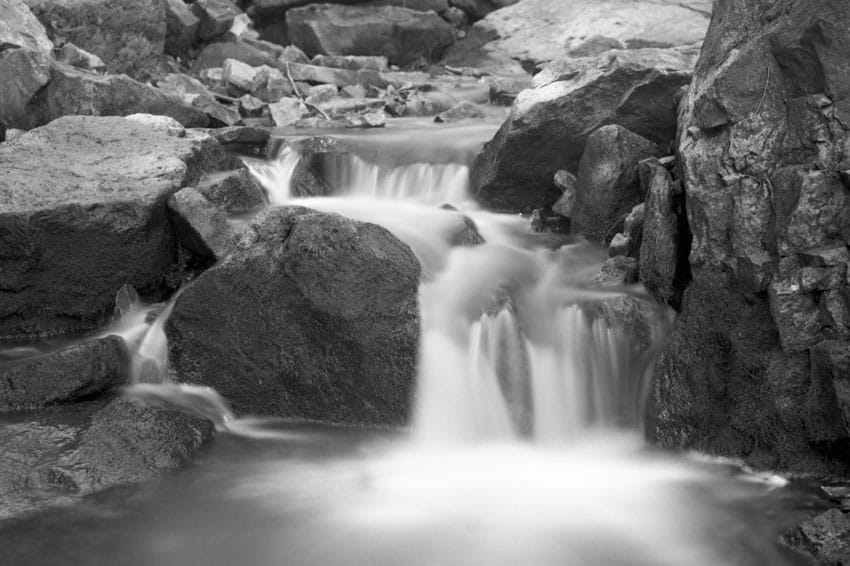
Written by Temi Lawson
Is expensive film stock always worth the money? Well, that is up to the photographer’s sentiment.
Recently, I took a trip to my local film store (Garland Camera) to try out and compare three different brands of black and white film stock to see which one would give me the best photos on a recent photoshoot I did.
All images were of impressive quality images. However, there were some I liked more than others, and I’ll explain why!

An Overview of the B&W Film Comparison
The film stocks I compared was Ilford Delta 100, FujiFilm Neopan Acros 100 II, and the Kodak T-Max 100.
Fuji Acros was the most expensive at around $13/roll, Kodak T-Max was the next most expensive at around $10/roll, and Ilford Delta was the least expensive at around $8/roll.
I bought them all at the same ISO of 100, all were 35mm to give a fair comparison in terms of image quality, and all three claim to be “fine grain.”
All of the images were shot on my Pentax ME Super 35mm camera with an aperture between 4-2, in studio using natural light, at 1/100 speed, and developed and scanned by a local lab. After reviewing my images (all had amazing quality), here were my findings.
You can also check out this comparison between Kodak Tri-X 400 and Kodak T-Max 400.
Fujifilm Neopan Acros 100 II
The Neopan Acros gave excellent contrast, and provided so much detail for a film camera. The images looked like they could have been taken on a digital camera.
The black it provided was a very pure and deep black giving more of vintage yet sharp look to the images. I also loved the way this camera flattered my models’ skin. Therefore, I would say this film is dark-skin friendly. It did not wash her out nor blend her into the dark tones.
Find Fujifilm Neopan Acros 100 II on Amazon.



Kodak T-Max 100
Next, the Kodak T-max 100 was probably the film stock I was least impressed with.
My biggest issue was that it looked VERY grainy (possibly due to lower ISO & needing more light). You could definitely tell it was shot on a film camera, and if that is something you are going for, then you might favor this one.
Another reason this stock wasn’t my favorite was because of the lack of contrast it gave. Instead of blacks and whites, I felt like it provided more of a gray overcast on all of the colors, and high contrast is something I like to see in black and white stock.
The image quality was still great, it just simply did not provide the outcome I was looking for.
Find Kodak T-Max 100 on Amazon.


Ilford Delta 100
The Ilford Delta 100 was the one I was most impressed with, and probably a close second out of the three next to the Neopan.
This stock produced some amazing images for sure, but the grain was still slightly visible. Nonetheless, the results could keep the untrained eye guessing if it was shot on digital or film, much like the FujiFilm Neopan.
The Ilford also gave a beautiful contrast but produced more of a warmer feel than the others. This did not take away from the overall quality of the images, but still something to keep in mind when considering how you want your images to look.
Find Ilford Delta 100 on Amazon.


The Final Verdict
Overall, my first choice would be the FujiFilm Neopan Acros 100 II. It gave the sharpest images with stunning quality with beautiful deep contrast. This film stock is one that I feel would suit all skin tones.
The Neopan stock was the most expensive but well worth the money. I could see myself purchasing this for wedding photoshoots or client work in the future.
A close second and probably the best budget option was the Ilford Delta 100. This one was the least expensive, so I was shocked when it provided almost as stunning quality as the Neopan stock did.
If I am wanting to save a little bit of money I would purchase this one hands-down.

As for Kodak, it wouldn’t be my top purchase. Again, it was not terrible quality, it just did not hold up to the other two options, especially given it was the second most expensive. I do feel like there are more affordable options with better quality.
In my YouTube video, I share all of my findings and image results on each film stock. I recommend checking it out because it depends on what look you’re looking for in film stock.
I know not everyone will appreciate the sharp digital aesthetic that I wanted, and may in fact be more impressed by the grainy vintage look.
Therefore, having a visual to compare results with your own opinion will suit you and your artistic vision best!

Thank you so much, Temi! You can find more of Temi’s work on her website, Instagram, and YouTube.
Leave your questions about Fuji Acros II 100, Ilford Delta 100, and Kodak T-Max 100 and this b&w film comparison below in the comments, and you can pick up some for yourself on Amazon here: Fujifilm Neopan Acros II 100, Ilford Delta 100, and Kodak T-Max 100







Blog Comments
Christopher
June 3, 2022 at 11:19 am
Nice article and pretty much parallels my own thoughts on these film stocks. What I would like to have had is a review of the developers used for these films. I have found that different developers can make a huge difference in the look of the same film. T max in one developer may be very fine-grained and contrasty while in another may be dull and grainy, for one small example. I have recently been using Clayton F76 with amazing results on all of these film stocks. AcrosII still comes out ahead, but looks so much better than it does developed in Ilford DDX, for example.
Thanks for the nice article. Great photos, too-Chris
Tony Gadong
June 3, 2022 at 11:34 am
How were the films developed and printed? In my experience with these films, there is variability with different developers and time of development. You have to set a benchmark for comparision.
I agree with you on Acros having a good grain structure. The new version release is great. The other two I found was too sensitive to development. The Kodac Plus X and Illford FP4 were my favorites prior to Fuji Acros.
In any case, your photographs are great. Keep up the good work.
Hank
June 3, 2022 at 11:42 am
TMax being the most grainy doesn’t seem right to me. TMax claims to have the finest grain of these three films, at least according to Kodak. I would suspect the processing was at fault. TMax is finicky with regard to developers.
I personally prefer Delta100 as it seems to have the best overall balance. The Fuji is sometimes too contrasty for me, and being biased toward orthochromatic, sometimes gives a harsh look. But in your instances, it seemed to do fine.
Allison
June 3, 2022 at 12:26 pm
Thank you so much for this comparison! Love seeing the results and the video. The images are beautiful! I’m excited to try Acros on my next roll of b&w.
Amy
June 3, 2022 at 2:47 pm
I loved seeing this comparison!!!! I rarely shoot 100 speed black and white film, so I was very interested in your findings. I’ve only shot TMax 100 in 120 and I haven’t shot the other two ever. Acros ii was the winner in my book as well. All your images are lovely, but the Acros images knocked it out of the park. Well done!
Brett Rogers
June 4, 2022 at 12:09 pm
All of these films are capable of high acutance, high resolution images—including Tmax 100. If you desire more contrast, the solution is to develop for a longer time. Excessive grain suggests the use of a less than ideal developer, or development technique, or both. I’ve obtained excellent, sharp, high resolution images from all these films in 135 & 120—well, OK, the original Acros 100, I have some Acros II here I haven’t tried yet—with nothing more exotic than Ilford ID-11 1+3, accurate exposure and sound development technique. Ditch the lab, and take full control over your black and white workflow. It will be worth it in the long run. 🙂
gnuyork
August 3, 2022 at 6:05 am
What developers were used?? Try T-Max in Xtol. Should give you much better results.
Jed Smith
September 1, 2022 at 1:28 am
This really comes down the the developer and agitation & times the lab used. Plus the scanner they used and whatever settings it’s defaulting to.
Your experiment was great – mostly because it showed you exactly what to use for the best results in your workflow. In a wet lab setup, where you develop the films yourself, if Xtol is used with the Tmax, it will likely have the finest grain. I’ve shot all three of these films several times, and it’s really splitting hairs between Tmax and Acros for finest grain, but Tmax probably just edges it in diluted Xtol. Delta 100 has slightly more grain when they are all processed optimally. However, I’m starting to like the Delta films for this reason – to me, it has a nice acutence – a real sharpness or crispness to the image that in my experience, I have to work harder to get from Tmax; and the grain feels just about right.
If you want even less grain than that Acros II, grab a roll of Adox CMS20, a tripod, and have a go – it’s amazing stuff. We have a 20×30 print from a drum scanned 35mm frame of it at our office, and no one can believe it was shot on 35mm film. 😉
Vilmos Vincze
October 22, 2023 at 6:03 am
Great review and great photographs!
As some commenters mentioned, I can confirm: Tmax indeed has the finest grain and great contrast – if developed in the dedicated Tmax developer. Thrown into the same developer as Acros and Ilford Delta, this fine film becomes just mediocre. So the choice of lab is important. All other observations: I can fully agree!
Paul R
February 3, 2025 at 10:56 am
The comparisons of the Fuji profiles with the actual measured charts are incredibly useful; thank you for this work.
The comparison of the black and white films deserves a similarly rigorous comparison. Unfortunately, the way you compared the 3 films gives results that are meaningless.
To understand the differences in a useful way, we’d need to see MTF measurements and (at least) close ups on the grain structure in different tones. And sensitometric curves. And all need to be given with the caveat that they represent a single film/developer combination.
All these films will respond differently to different developers and development. I created my own developer for Tmax 100 sheet film, to best take advantage of some of its characteristics. The results look nothing like yours. Likewise D-76, HC-110, and T-Max developer all produce different results. As do different dilutions and times with these same developers.
And please stop using phrases like “excellent contrast” to describe a film. This is meaningless. Completely meaningless. Any black and white film can give you whatever contrast you want, if you know how to use it. If you’re talking about dynamic range or curve shape, that’s different, but all these qualities are both subjective and malleable.
Ernest Leyba
April 11, 2025 at 1:36 pm
You did a nice comparison and I agree the Fuji was my choice. However I think the processing has a lot to do with contrast, grain. I have used Tmax 100 and have have been pleased with grain and contrast.
steve marino
June 10, 2025 at 11:11 pm
Thank you for doing this test. I know they’re tedious and very time consuming, but you came up w/ some excellent examples. Neopan is of course long gone now, but both Tmax 100 and Delta 100 are still around. Yesterday I shot a roll of Tmax 100 at box speed and developed it in Rodinal 1:40. It was OK, nothing special, but at EI 20 in Rodinal and developed 1: 25……….wow!